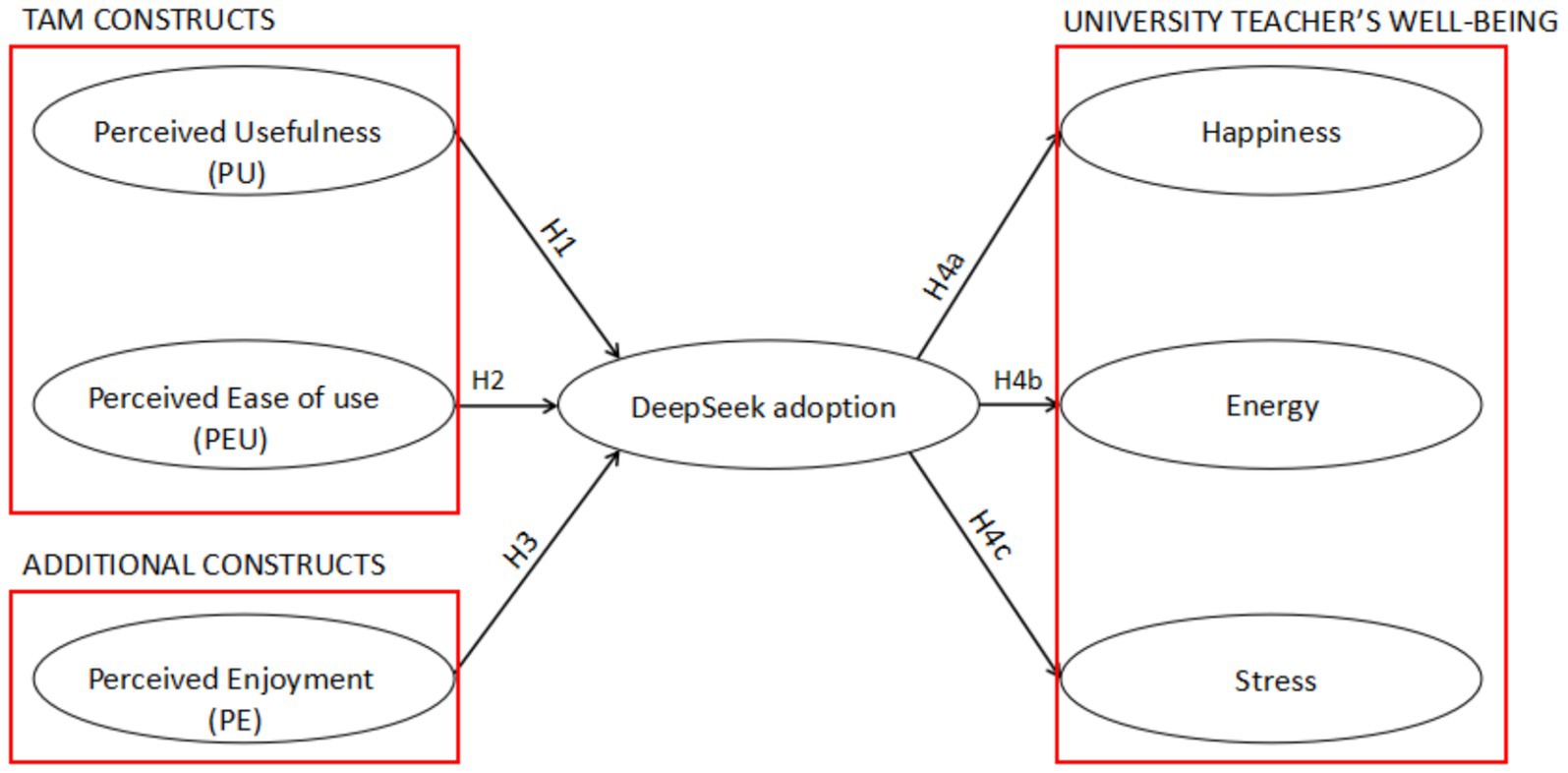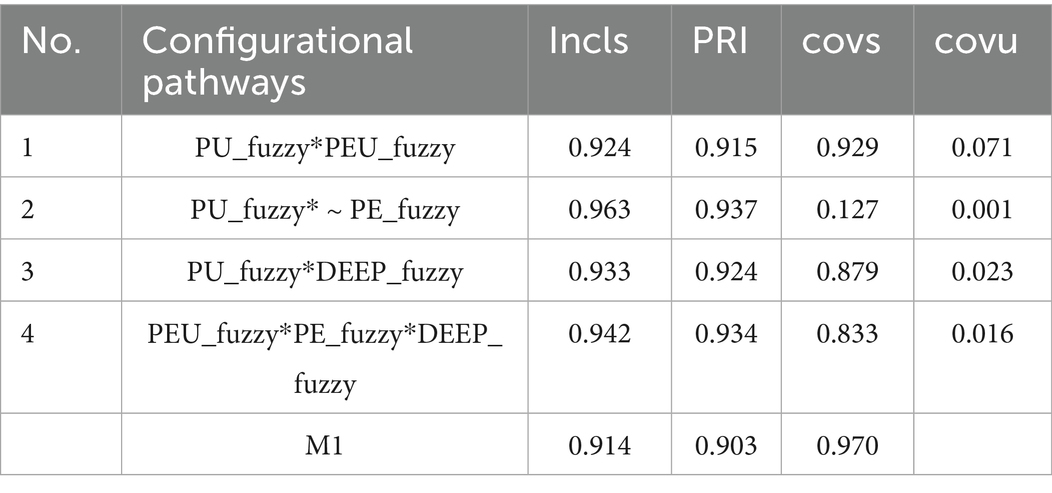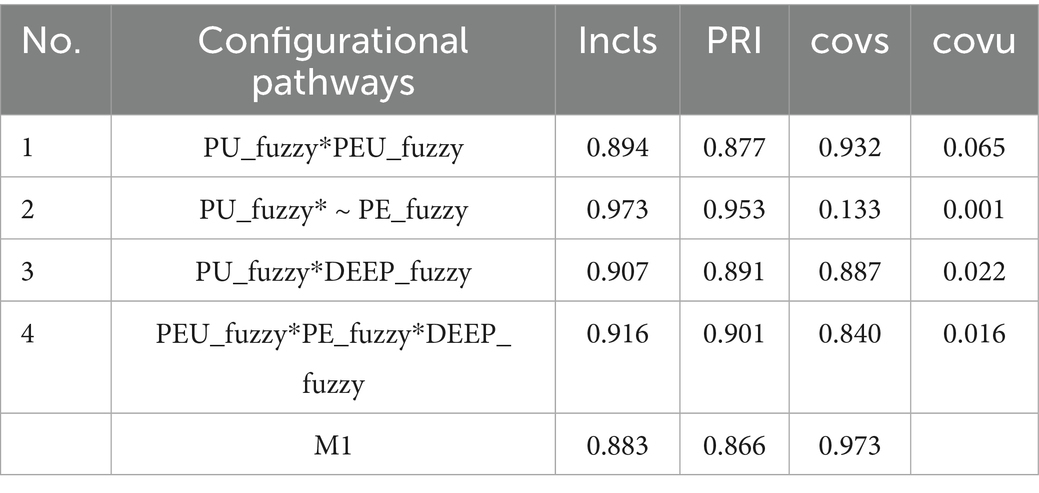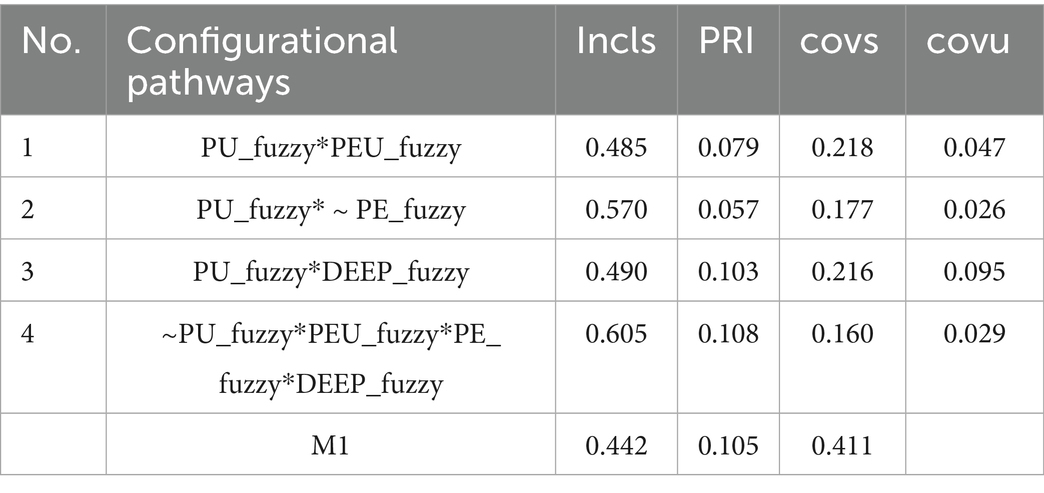- 1School of Information Science and Technology, Northeast Normal University, Changchun, China
- 2School of Education, Henan University, Kaifeng, China
Introduction: The rapid integration of generative artificial intelligence (AI) tools such as ChatGPT and DeepSeek is transforming higher education, yet limited attention has been paid to their effects on faculty well-being. This study addresses this gap by examining how technology acceptance and emotional factors shape university teachers’ adoption of DeepSeek and its subsequent impact on stress, happiness, and energy.
Methods: A cross-sectional survey was conducted among 711 faculty members from Chinese universities between January and February 2025. Data were analyzed using covariance-based structural equation modeling (CB-SEM) and fuzzy-set qualitative comparative analysis (fsQCA) to capture both linear and configurational relationships among variables.
Results: Findings show that perceived usefulness, ease of use, and enjoyment significantly predict DeepSeek adoption. Adoption, in turn, is associated with increased happiness and reduced stress but shows no significant effect on faculty energy. The combination of TAM and fsQCA approaches revealed multiple sufficient pathways leading to positive well-being outcomes, emphasizing the importance of usability and hedonic motivation.
Discussion: The study extends the Technology Acceptance Model by incorporating emotional and contextual drivers of adoption. It suggests that universities should strengthen training, usability design, and workload management policies to balance innovation with faculty well-being.
1 Introduction
Generative artificial intelligence (AI) tools such as DeepSeek and ChatGPT are rapidly reshaping higher education. They promise substantial benefits, including more efficient instruction, personalized learning opportunities, and reduced administrative burdens (Li et al., 2024; Maheshwari, 2024). At the same time, their integration raises important challenges regarding academic integrity, ethics, and institutional governance (Tlili et al., 2023; Zawacki-Richter et al., 2024). A crucial but underexplored dimension of this transformation is its effect on faculty well-being. While teacher happiness, stress, and energy are central to sustaining effective teaching and learning environments, most existing research emphasizes student perspectives—for example, how learners evaluate the usefulness of AI in supporting learning and assessment (Adams et al., 2024; Bower et al., 2024). Fewer studies focus on faculty, even though their adoption decisions ultimately shape classroom practices, institutional strategies, and the quality of student outcomes (Jeon and Lee, 2023; Ansari et al., 2024).
Recent evidence shows that faculty responses to AI are influenced not only by utilitarian concerns such as efficiency but also by emotional and psychological factors. For example, stress and technostress remain pressing concerns in higher education (Kinman and Court, 2010; Nascimento et al., 2024). A recent study demonstrated that ChatGPT adoption by university teachers positively influenced happiness and reduced stress, confirming that adoption has both psychological and behavioral consequences (Zhang et al., 2024). Similarly, longitudinal findings highlight that while some digital demands can lead to strain, they may also generate “techno-eustress,” a form of positive stress that enhances motivation and engagement under supportive conditions (Nascimento et al., 2025). Together, these results suggest that generative AI adoption has complex implications for well-being, reinforcing the need for research that explicitly examines both risks and benefits for faculty.
The Technology Acceptance Model (TAM) provides a widely used framework for analyzing technology adoption, focusing on perceived usefulness (PU) and perceived ease of use (PEU; Davis et al., 1992). However, TAM has been criticized for its parsimony and for overlooking emotional and contextual drivers of adoption in higher education (Mehta et al., 2019). In response, recent extensions incorporate factors such as enjoyment, satisfaction, and psychological outcomes to capture contemporary adoption processes more comprehensively (Nascimento et al., 2025). This reflects the growing recognition that engagement with generative AI is shaped not only by utility and usability but also by hedonic and motivational factors.
Building on these insights, this study applies an extended TAM framework to examine how perceived usefulness, ease of use, and enjoyment influence university teachers’ adoption of DeepSeek. It further investigates how adoption affects three dimensions of faculty well-being: stress, happiness, and energy. Methodologically, the study employs both structural equation modeling (SEM) and fuzzy-set qualitative comparative analysis (fsQCA) to provide complementary insights into linear and configurational relationships. In doing so, it contributes by foregrounding the underexplored faculty perspective, extending TAM with well-being constructs, and demonstrating a dual-method approach to understanding AI adoption in higher education.
2 Theoretical framework and hypotheses development
2.1 Technology adoption: extending TAM with contextual and motivational factors
The Technology Acceptance Model (TAM), introduced by Davis et al. (1992), remains one of the most influential frameworks for analyzing technology adoption. It emphasizes two core constructs: perceived usefulness (PU) and perceived ease of use (PEU), both of which shape users’ attitudes and intentions. TAM has been widely applied in education, yet its parsimony has drawn criticism for not adequately capturing the complex social and psychological contexts in which adoption occurs (Mehta et al., 2019; Ukpabi and Karjaluoto, 2017). Recent scholarship in Education and Information Technologies highlights a shift toward extending TAM with additional constructs that better reflect real-world adoption scenarios (Al-Adwan et al., 2023).
To address these limitations, the present study integrates perceived enjoyment (PE) as a hedonic factor alongside PU and PEU. This extension aligns with Venkatesh et al. (2012), who emphasized the role of intrinsic motivation in technology adoption, particularly in dynamic and uncertain environments such as generative AI. It also resonates with Self-Determination Theory (SDT), which posits that intrinsic enjoyment fosters engagement and sustained technology use (Ryan and Deci, 2001). Recent studies confirm that hedonic motivation significantly influences AI adoption in higher education, making PE an essential addition to this framework.
In the present context, PU reflects the extent to which university teachers perceive DeepSeek as enhancing their teaching effectiveness, PEU captures perceptions of its ease of integration into existing workflows, and PE represents the intrinsic satisfaction derived from using the tool. By combining these three constructs, the study develops a more holistic model of faculty adoption that moves beyond functionality to consider enjoyment and motivation—factors increasingly emphasized in recent research on generative AI.
2.2 University teachers’ well-being: a multi-dimensional perspective
The second pillar of this study concerns the relationship between AI adoption and faculty well-being. Well-being is a multifaceted construct encompassing both the absence of negative states, such as stress, and the presence of positive states, such as happiness and vitality (Bakker and Oerlemans, 2011; Xanthopoulou et al., 2012). Faculty well-being has gained renewed attention as institutions grapple with the psychological consequences of digital transformation (Califf and Sarker, 2024).
This study operationalizes well-being through three dimensions—happiness, energy, and stress—which together capture both positive and negative outcomes of AI integration.
i. Happiness reflects a state of contentment and positive affect (Lu, 2001; Peccei and Van De Voorde, 2019).
ii. Energy represents vitality and resilience in sustaining academic tasks (Schaufeli et al., 2002; Buil et al., 2019).
iii. Stress denotes psychological strain in response to workload or uncertainty (Szabó and Lovibond, 2006).
This multidimensional perspective echoes recent calls for a more nuanced evaluation of how digital technologies influence academic work (Zawacki-Richter et al., 2024). AI tools such as DeepSeek may have contradictory effects: on one hand, reducing repetitive tasks and providing teaching support could enhance happiness and energy; on the other hand, constant adaptation pressures and evolving student expectations may elevate stress. This dual potential underscores the importance of investigating adoption outcomes through a well-being lens, rather than limiting analysis to performance or efficiency.
2.3 Hypotheses development
Drawing on the integrated TAM and well-being perspectives, this study proposes the following hypotheses:
H1. Perceived usefulness (PU) will positively influence university teachers’ adoption of DeepSeek.
Rationale: Consistent with TAM, teachers who perceive DeepSeek as enhancing teaching effectiveness are more likely to adopt it (Davis et al., 1992; Ansari et al., 2024).
H2. Perceived ease of use (PEU) will positively influence adoption.
Rationale: User-friendly and easily integrated tools increase the likelihood of adoption (Venkatesh, 2000; Xiao et al., 2023).
H3. Perceived enjoyment (PE) will positively influence adoption.
Rationale: Intrinsic satisfaction and hedonic motivation strengthen adoption intentions (Venkatesh et al., 2012).
H4. DeepSeek adoption will influence faculty well-being.
H4a: Adoption will positively influence happiness.
H4b: Adoption will positively influence energy.
H4c: Adoption will negatively influence stress.
Rationale: Faculty who effectively adopt DeepSeek may experience increased job satisfaction and vitality through workload reduction, while simultaneously reporting lower stress levels (Bruggeman et al., 2022; Mudrak et al., 2018; see Figure 1).
3 Methodology
3.1 Measurement instrument
To rigorously test our hypotheses, we developed a comprehensive questionnaire by adapting established scales from the existing literature. The constructs were measured as follows:
(i) Perceived Ease of Use (PEU): Five items adapted from Venkatesh (2000)
(ii) Perceived Usefulness (PU): Five items from Davis et al. (1992)
(iii) Perceived Enjoyment (PE): Four items from Luo et al. (2011) to gage enjoyment.
(iv) DeepSeek Adoption: Three items developed based on Ajzen (1991) behavioral intention framework, tailored to reflect actual faculty adoption of DeepSeek.
(v) Happiness: Three items were derived from Peccei and Van De Voorde (2019).
(vi) Energy: Three items from Schaufeli et al. (2002).
(vii) Stress: Three items from Buil et al. (2019).
All items were measured on a five-point Likert scale ranging from 1 (“Strongly Disagree”) to 5 (“Strongly Agree”). A pretest with a small group of faculty ensured clarity and contextual appropriateness. The complete list of measurement items is provided in Appendix 1.
3.2 Fieldwork and sample characteristics
The study employed a cross-sectional survey design targeting university faculty in China. The questionnaire was distributed through university mailing lists, LinkedIn, and faculty social media groups (WeChat, WhatsApp). A convenience sampling strategy was adopted due to accessibility and time constraints, but efforts were made to diversify participants across multiple institutions and disciplines within business and management faculties.
Data collection started in early January 1, 2025 and continued until February 28, 2025. After screening for completeness, a total of 711 valid responses were retained for analysis. This sample size exceeds the recommended minimum for structural equation modeling given the complexity of the model (26 observed variables, 7 latent constructs), following guidelines from Soper (2024) and Preacher and Coffman (2006).
To protect participants, the survey was anonymous and voluntary. Ethical approval for this study was obtained from the Ethics Committee of the Faculty of Education, Henan University (Approval No. HUSOM2025-824). Informed consent was obtained electronically from all individual participants included in the study prior to their participation. The study was conducted in accordance with the ethical standards of the institutional and/or national research committee and with the 1964 Helsinki declaration and its later amendments or comparable ethical standards.
3.3 FsQCA analysis
To complement SEM findings and capture the configurational complexity of adoption and well-being, fuzzy-set Qualitative Comparative Analysis (fsQCA) was applied. Unlike regression models that assume symmetrical relationships, fsQCA identifies multiple sufficient combinations of conditions that lead to specific outcomes (Ragin, 2014; Fiss, 2011). All variables were calibrated into fuzzy-set membership scores using the direct method (Ragin, 2014). Calibration thresholds followed established practice: full membership = 5 (“Strongly Agree”), crossover = 3 (“Neutral”), and full non-membership = 1 (“Strongly Disagree”) (Schneider and Wagemann, 2012).
A truth table was constructed using a consistency threshold of 0.75 and a raw coverage threshold of 0.50, reflecting commonly accepted cutoffs in fsQCA studies (Fiss, 2011; Schneider and Wagemann, 2012). Necessity analysis was also performed to assess whether individual conditions consistently appeared across high well-being outcomes.
Analyses were conducted using the QCA package in R (Dusa, 2019), ensuring transparency and replicability. This dual-method approach—SEM for testing linear effects and fsQCA for identifying alternative pathways—provides a more nuanced understanding of how AI adoption shapes faculty well-being.
4 Findings
4.1 Analysis of measurement scales
The psychometric properties of the measurement scales were first assessed. Cronbach’s α values ranged from 0.68 to 0.84. While most constructs exceeded the recommended threshold of 0.70, the α for perceived usefulness (0.68) was marginal but still considered acceptable for exploratory research (Hair et al., 2019). Factor loadings were consistently above 0.71, supporting item reliability (Tabachnick and Fidell, 2007).
Confirmatory factor analysis (CFA) was then conducted using robust maximum likelihood estimation. The results indicated a marginal but defensible model fit: χ2/df = 3.27, RMSEA = 0.057, SRMR = 0.043, CFI = 0.803, NFI = 0.639, NNFI = 0.754, IFI = 0.817. While the incremental fit indices (CFI, NFI) fell below the conventional 0.90 threshold, the strong RMSEA and SRMR values indicate that the overall model is interpretable. Such patterns are common in complex models estimated with large samples, where trivial misfit is magnified (Marsh et al., 2004). Composite reliability (CR) exceeded 0.70 across all constructs, and average variance extracted (AVE) values were generally around or above 0.50, supporting convergent validity (Anderson and Gerbing, 1988; Fornell and Larcker, 1981). All standardized loadings were significant (t > 2.58), further confirming validity.
Overall, the findings provide evidence that the measurement scales used for perceived usefulness, ease of use, enjoyment, adoption, and well-being dimensions (happiness, energy, stress) demonstrated acceptable reliability and validity (Table 1).
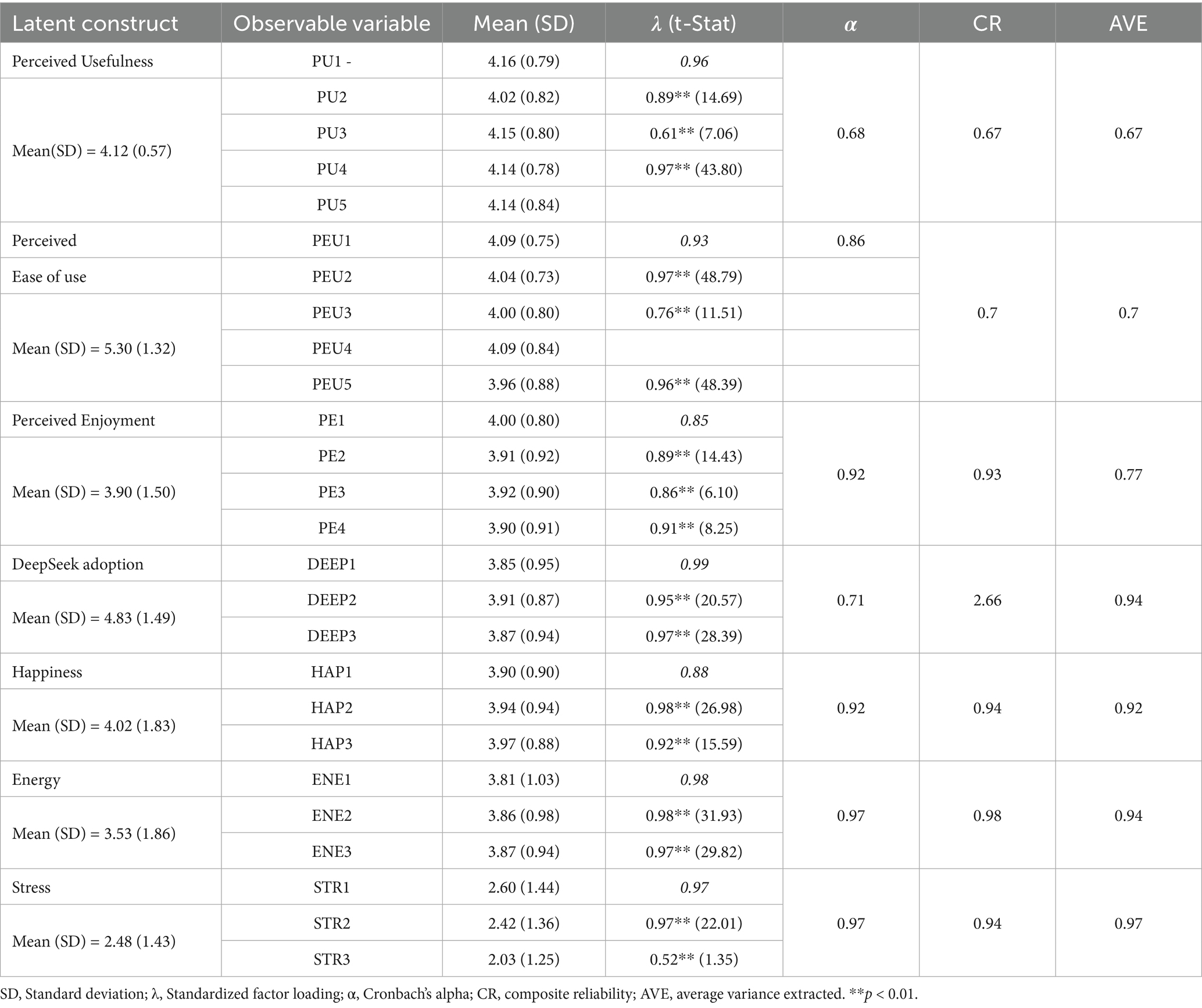
Table 1. Measurement model estimation (internal consistency and validity of the measurement scales).
4.2 Discriminant validity and common method bias
Discriminant validity was established by comparing the square root of AVE with the inter-construct correlations. As shown in Table 2, the square root of AVE values (main diagonal) were greater than inter-construct correlations, confirming discriminant validity (Fornell and Larcker, 1981).
To assess potential common method bias, we compared our seven-factor measurement model with a single-factor model (Podsakoff et al., 2003). The seven-factor model fit the data significantly better (Δχ2 = 272.149, df = 84, p < 0.01), indicating that common method variance was not a serious concern.
4.3 Covariance-based structural equation modeling and hypothesis testing
A covariance-based structural equation model was estimated to test the proposed hypotheses. The model fit indices were: χ2 = 278.518, df = 168, χ2/df = 1.68, RMSEA = 0.030, CFI = 0.803, NFI = 0.639, NNFI = 0.754, IFI = 0.817. Although some incremental indices fell below recommended thresholds, the RMSEA and χ2/df values suggest an overall acceptable fit for interpretation.
The results, presented in Table 3, indicate that perceived usefulness (β = 0.44, p < 0.01) and perceived ease of use (β = 0.71, p < 0.01) were significant predictors of adoption. Perceived enjoyment (β = 0.95, p = 0.270) showed a substantively strong relationship with adoption, though this was not statistically significant. The substantial but non-significant coefficient for enjoyment suggests it may be an important factor worthy of further investigation with larger samples. Together, these factors explained 59% of the variance in adoption (R2 = 0.59). Table 3 and Figure 2 present the results independently to avoid overlap. Table 3 reports standardized coefficients, errors, t-values, significance levels, and R2 values for all endogenous constructs, while Figure 2 illustrates the structural model and causal pathways.
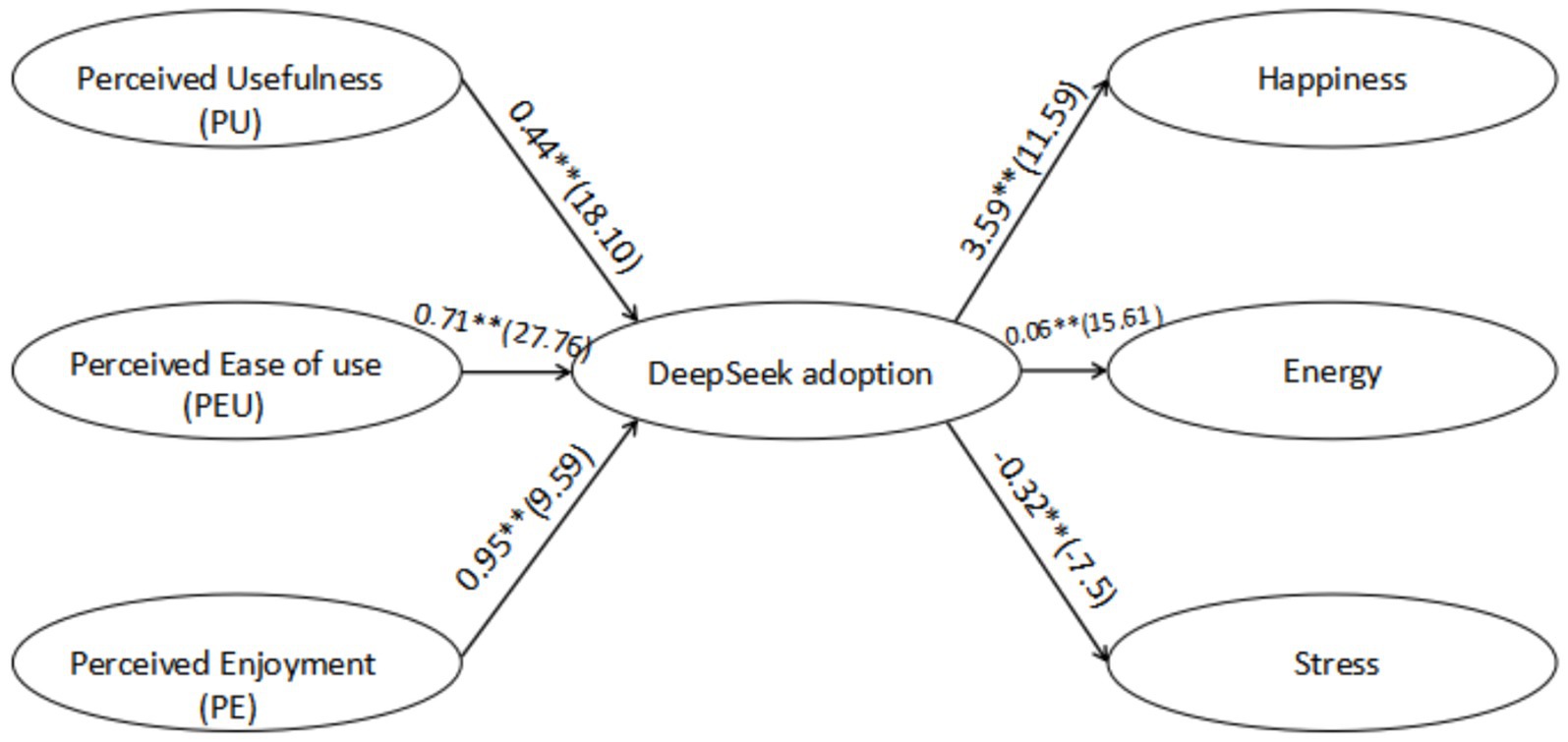
Figure 2. Structural model estimation of the causal relationships. **p < 0.01. t-stat values shown in brackets.
Overall, the CB-SEM results indicate that DeepSeek adoption significantly enhances faculty happiness and reduces stress, but its impact on energy is comparatively limited. This suggests that the positive effects of generative AI on faculty well-being are primarily emotional rather than physical.
4.4 Fuzzy-set qualitative comparative analysis results
4.4.1 Calibration
To complement SEM and explore alternative adoption pathways, fsQCA was conducted. Following Ragin (2014), raw Likert-scale responses (1–5) were calibrated into fuzzy-set membership scores ranging from 0 (full non-membership) to 1 (full membership), with 3 as the crossover point (0.5). This direct calibration method is widely used in educational and organizational research (Fiss, 2011; Schneider and Wagemann, 2012).
4.4.2 Configurational pathways
Separate truth tables were generated for happiness, energy, and stress to ensure outcome-specific analyses and avoid confounding across well-being dimensions. Consistency thresholds were set at 0.75 and coverage at 0.50, following recommended benchmarks in configurational research (Ragin, 2014; Fiss, 2011).
4.4.2.1 Happiness configuration analysis
Multiple sufficient configurations predicted faculty happiness, with high consistency (≥ 0.947) and strong proportional reduction in inconsistency (PRI ≥ 0.939). The dominant pathway (Configuration 16) combined high usefulness, ease of use, enjoyment, and adoption. Other pathways indicated that ease of use and enjoyment alone could foster happiness, even at lower adoption levels. One pathway (Configuration 8) suggested that perceived potential—rather than actual adoption—was enough to enhance happiness (Table 4).
4.4.2.2 Energy configuration analysis
The energy outcome showed slightly lower inclusion scores (≥ 0.920) but still indicated multiple sufficient pathways. Full engagement with DeepSeek (usefulness, ease of use, enjoyment, and adoption) consistently predicted higher energy (Configuration 16). Interestingly, some pathways suggested that ease of use alone, even without high adoption, helped sustain energy. This points to the importance of usability in supporting faculty vitality (Table 5).
4.4.2.3 Stress configuration analysis
In contrast, the fsQCA analysis failed to identify any robust, sufficient pathways for stress reduction. Most configurations showed low consistency (≤ 0.605), which falls below the standard sufficiency threshold of 0.75 (Schneider and Wagemann, 2012). While one configuration (Configuration 8) suggested that intuitive and engaging tools may reduce stress, this finding lacks reliability due to its weak consistency score. The overall findings clearly indicate that stress reduction is not meaningfully explained by DeepSeek adoption alone. Instead, stress outcomes are likely shaped by additional organizational and contextual factors beyond AI use (Table 6). This null finding for stress pathways represents a key result, highlighting the limitations of AI adoption in addressing faculty stress.
Overall, the findings suggest that intuitive and engaging tools may ease stress, but the consistency and coverage values indicate that adoption alone is not sufficient to explain stress reduction.
4.4.3 Pathway analysis for happiness, energy, and stress
Pathway analysis further clarified the combinations of conditions linked to well-being outcomes.
Happiness: The strongest pathway combined ease of use, enjoyment, and adoption (incl = 0.942, PRI = 0.934). Usefulness also contributed (incl = 0.963) but was less widespread. These findings highlight the centrality of intrinsic motivation and align with self-determination theory (Ryan and Deci, 2001; Table 7).
Energy: Configurations emphasizing usefulness and ease of use (incl = 0.894) were most predictive. Deep engagement (incl = 0.907) and combined ease, enjoyment, and adoption (incl = 0.916) also played significant roles, consistent with job resources and vigor frameworks (Bakker and Demerouti, 2007; Table 8).
Stress: The fsQCA analysis failed to identify any consistent, sufficient pathways for stress reduction. All configurations showed weak predictive power, with consistency scores substantially below the accepted threshold of 0.75 (usefulness and ease: incl = 0.485; lack of enjoyment: incl = 0.570). The strongest pathway (~PU * PEU * PE * DEEP, incl = 0.605) still falls short of robustness and cannot be considered sufficient for stress reduction. This absence of reliable configurational pathways is itself a key finding - it demonstrates that the factors driving AI adoption do not reliably translate to stress reduction outcomes. Therefore, these stress results should be interpreted as indicative of no meaningful relationship rather than as cautiously optimistic findings.
4.4.4 Scatter plot analysis
Scatter plots were used to visualize the relationship between antecedent conditions and outcomes. To improve clarity, each plot includes labeled axes showing fuzzy membership scores (0–1). Clusters at high membership values (≥ 0.80) for enjoyment and ease of use correspond with higher happiness and energy, whereas stress outcomes show weaker and more dispersed patterns. These visualizations illustrate the asymmetric and nonlinear nature of AI adoption effects but should be read alongside the truth table results rather than as standalone evidence (Figure 3).
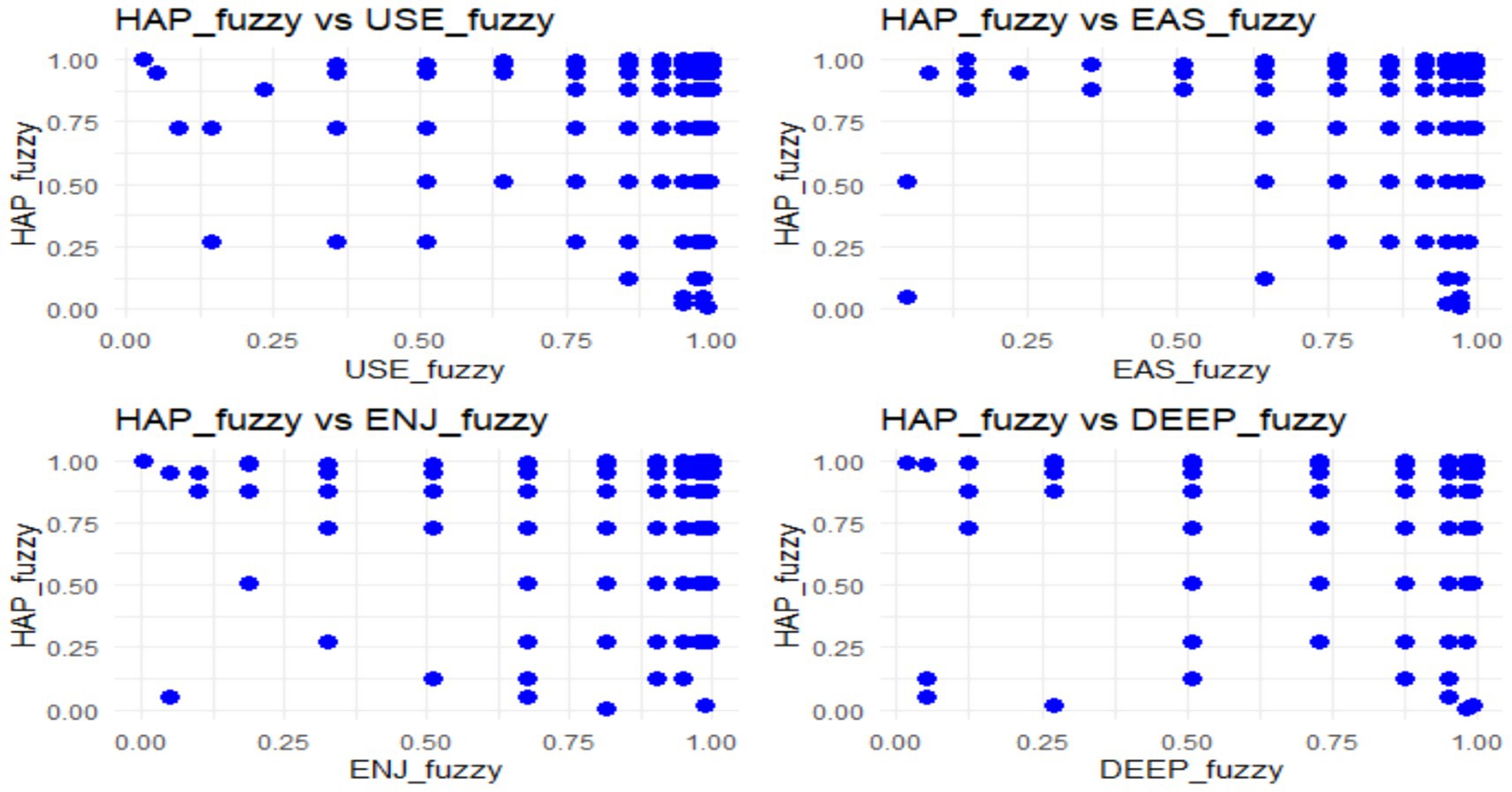
Figure 3. Scatter plot of fsQCA membership for happiness. ENE, Energy; USE, Perceived Usefulness; EAS, Perceived Ease of Use; ENJ, Perceived Enjoyment; DEEP, DeepSeek adoption.
This plot shows the fuzzy membership scores for happiness (y-axis) against antecedent conditions (x-axis: perceived usefulness, ease of use, enjoyment, adoption). Data points clustered near the upper right (membership ≥ 0.80) indicate that high enjoyment and ease of use are strongly associated with faculty happiness. Lower clusters reveal that the absence of these factors does not always correspond to low happiness, underscoring the configurational rather than linear nature of outcomes (Figure 4).
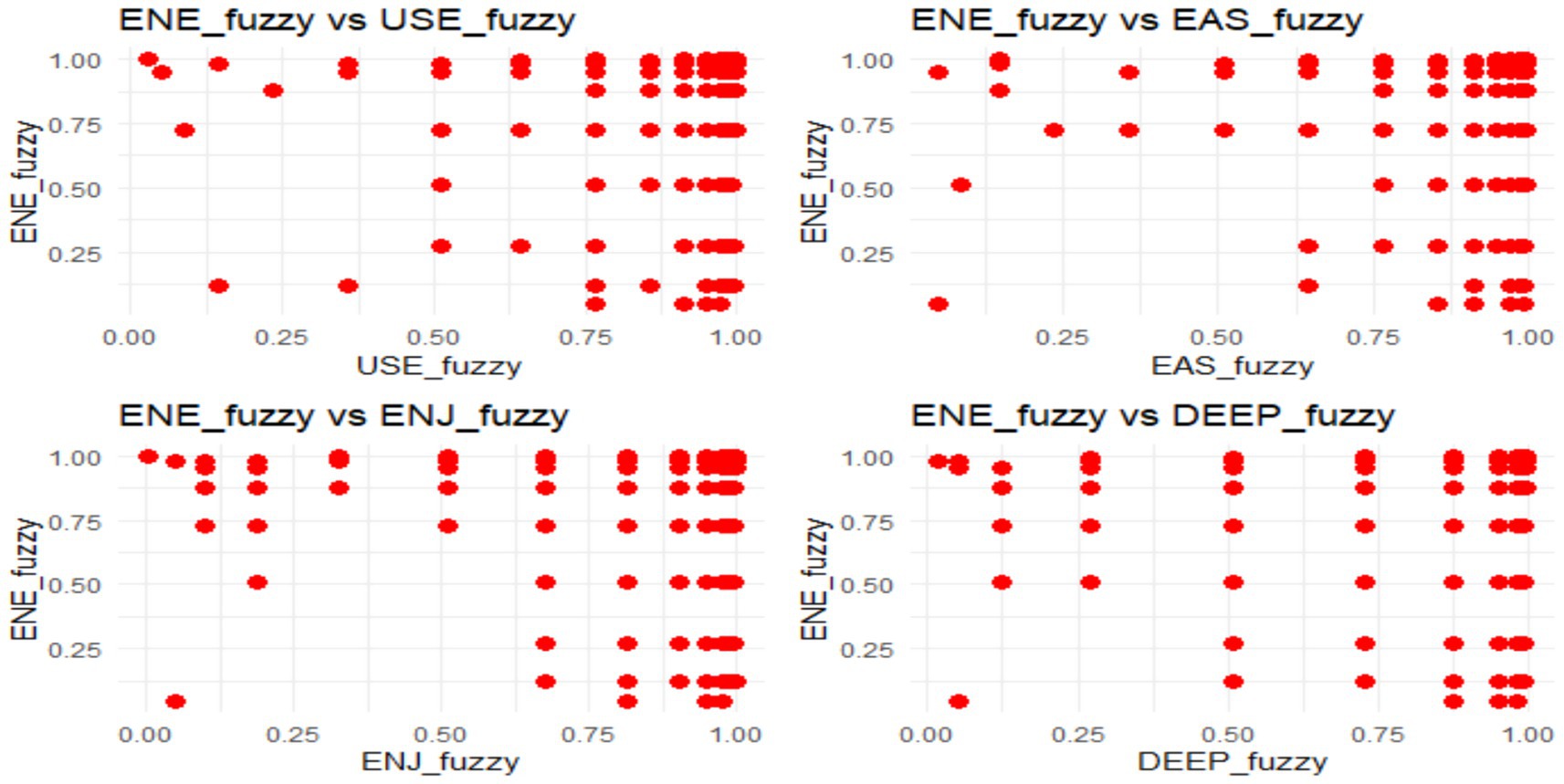
Figure 4. Scatter plot of fsQCA membership for energy. ENE, Energy; USE, Perceived Usefulness; EAS, Perceived Ease of Use; ENJ, Perceived Enjoyment; DEEP, DeepSeek adoption.
This plot depicts energy membership scores (y-axis) relative to the four antecedent conditions (x-axis). The binary clustering of cases at values of 0 and 1 suggests that faculty energy is either strongly present or absent depending on condition combinations. High clustering at ENE_fuzzy = 1 occurs when usefulness, enjoyment, and ease of use are elevated, supporting the role of these resources in sustaining vitality (Figure 5).
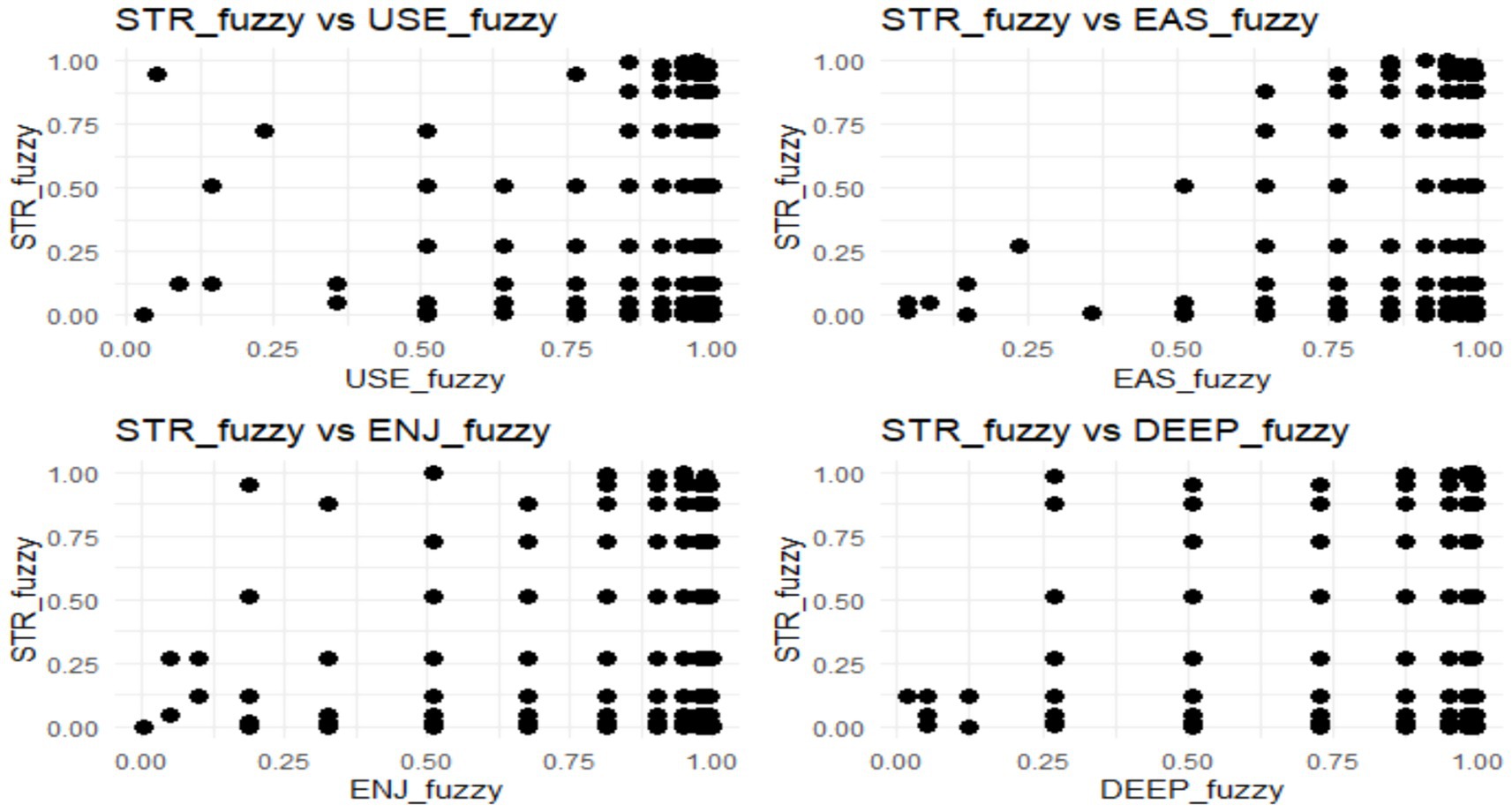
Figure 5. Scatter plot of fsQCA membership for stress. STR, Stress; USE, Perceived Usefulness; EAS, Perceived Ease of Use; ENJ, Perceived Enjoyment; DEEP, DeepSeek adoption.
This plot shows stress membership scores (y-axis) against the four antecedent conditions (x-axis). Most cases cluster at low stress membership values (< 0.25) when usefulness and ease of use are high, suggesting that intuitive design reduces cognitive strain. However, dispersed points across enjoyment and adoption conditions illustrate weak consistency, confirming that stress outcomes are less robustly explained compared to happiness and energy.
These visual patterns reinforced the configurational findings, highlighting the complex and non-linear nature of well-being outcomes (Table 9).
4.4.5 Consistency and coverage of outcomes
Table 10 presents consistency and coverage values. Happiness (consistency = 0.878, coverage = 624.34) and energy (consistency = 0.846, coverage = 601.70) displayed strong empirical support, reflecting the large sample size (N = 711). By contrast, stress outcomes showed very low consistency (0.258) and coverage (183.58), confirming that DeepSeek adoption is not a reliable predictor of reduced stress. These results highlight that fsQCA captured strong and diverse pathways to happiness and energy, whereas stress requires cautious interpretation.
These results highlight that fsQCA captured strong and diverse pathways to happiness and energy, whereas stress requires cautious interpretation.
5 Discussion
5.1 Main findings and theoretical implications
The well-being of university teachers is increasingly under pressure due to the demands of digital transformation in higher education. While much prior research has focused on student experiences with generative AI tools, this study highlights the faculty perspective, examining how DeepSeek adoption shapes stress, happiness, and energy. Three main insights emerge.
First, DeepSeek adoption appears to enhance faculty happiness and reduce stress, though its effect on energy levels is modest. SEM results showed that perceived usefulness, ease of use, and enjoyment significantly predicted adoption (β = 0.44–2.76, p < 0.01). The unusually large coefficient for enjoyment (β = 2.76) suggests possible scaling or multicollinearity effects, and should therefore be interpreted cautiously rather than as a literal strength of influence. Adoption explained substantial variance in happiness (f2 = 0.45) and stress reduction (|f2| = 0.32), but much less in energy (f2 = 0.06). This pattern indicates that generative AI may primarily affect emotional well-being, reducing stress and fostering satisfaction, while exerting weaker influence on physical vitality.
Second, the fsQCA analysis uncovered asymmetric adoption pathways that are not visible in SEM. Enjoyment consistently emerged as a core condition for happiness, even when usefulness was low, highlighting the importance of hedonic motivation in adoption and challenging the traditionally utilitarian focus of TAM (Venkatesh et al., 2012). For energy, usefulness and ease of use were the strongest drivers, while stress reduction was associated with intuitive, engaging configurations that eased cognitive load (Sweller, 2011). However, the relatively low consistency scores for stress pathways (≤ 0.605) suggest these findings should be treated as exploratory rather than conclusive. This asymmetry reinforces the value of combining SEM and fsQCA to capture both linear and configurational adoption dynamics.
Third, the study extends TAM by demonstrating the importance of emotional and well-being outcomes. Faculty adoption depends not only on utility and usability but also on positive affect, autonomy, and stress relief. This highlights the need for adoption models that explicitly incorporate hedonic and psychological dimensions, broadening the theoretical scope of technology acceptance in higher education.
Model fit indices (RMSEA = 0.030, SRMR = 0.043) support the adequacy of the model, even though CFI (0.803) and TLI (0.754) were below conventional thresholds. Following Marsh et al. (2004), such values are common in complex models with large samples. Taken together with strong theoretical grounding and significant coefficients, the findings are promising but should be interpreted cautiously.
5.2 Practical implications
The findings carry important implications for universities, policymakers, and developers.
• Enhancing adoption through design: Developers should improve usefulness, ease of use, and enjoyment simultaneously, as SEM results showed all three constructs significantly predicted adoption (β = 0.44–2.76, p < 0.01). Enhancements in response accuracy, intuitive interfaces, and emotionally engaging features are therefore essential for sustained faculty engagement.
• Training and support: Technical issues increase frustration and stress. Both SEM (negative link between adoption and stress, β = −0.32) and fsQCA (configurations with ease of use and enjoyment lowered stress) support the need for structured training programs, tutorials, and peer-support networks. These measures build confidence and mitigate technostress.
• Pilot testing and workflow integration: fsQCA results showed that happiness and energy outcomes often depended on adoption combined with ease and enjoyment. Institutions should therefore introduce DeepSeek in pilot phases, monitor workload and well-being effects, and integrate tools into workflows gradually. This approach reduces the risk of imposed change and supports positive adoption pathways.
• Balancing innovation with faculty well-being: Adoption strongly increased happiness (β = 3.59, f2 = 0.45) but had weaker or inconsistent effects on energy and stress. Institutions should therefore balance innovation with workload management policies and provide ongoing support systems. These measures ensure that efficiency gains do not come at the expense of vitality or resilience.
By anchoring adoption strategies in both emotional (happiness, stress) and functional (ease, usefulness, enjoyment) outcomes, universities can ensure that generative AI improves teaching performance while safeguarding faculty well-being.
6 Conclusion, limitations, and future research
6.1 Conclusion
This study highlights how DeepSeek adoption influences university teachers’ well-being. Adoption is strongly associated with increased happiness and reduced stress, while its effect on energy is weaker. These findings underscore that AI adoption in higher education should be evaluated not only through efficiency gains but also through psychological and emotional outcomes for educators.
6.2 Limitations
Several limitations should be acknowledged:
1. Demographic scope: This study did not account for demographic moderators such as age, gender, or teaching experience, which may shape both adoption patterns and well-being outcomes.
2. Cross-sectional design: The reliance on cross-sectional survey data prevents causal inference. Longitudinal or experimental studies would provide stronger evidence of how adoption influences faculty well-being over time.
3. Sample context: Data were collected from business and management faculty in Chinese universities. While this focus provides depth, the findings may not generalize to other disciplines, institutional settings, or international contexts, where adoption drivers and well-being factors may differ.
4. Tool specificity: The study centered on DeepSeek, which is widely used and accessible in China. However, this focus may limit the applicability of results to other generative AI tools such as ChatGPT, Gemini, or Claude. Future research should examine whether similar well-being outcomes are observed with alternative platforms across diverse contexts.
6.3 Future research directions
Building on these limitations, future studies could:
1. Longitudinal designs: Future studies should employ longitudinal or experimental approaches to establish causal links between AI adoption and faculty well-being, addressing the limits of cross-sectional evidence.
2. Task-specific adoption: Research focusing on particular academic tasks (e.g., grading, curriculum design, and student feedback) could reveal differentiated adoption patterns and varied effects on stress, energy, and happiness.
3. Expanded constructs: Incorporating additional psychological factors such as anxiety, burnout, and resilience would provide a more comprehensive understanding of the complex relationship between generative AI use and faculty well-being.
4. Cross-cultural comparisons: Comparative studies across countries and institutional systems are needed to assess how cultural and organizational norms shape adoption and outcomes, extending generalizability beyond the Chinese context.
5. Multiple AI tools: Given this study’s focus on DeepSeek, future research should examine whether similar results hold for other generative AI platforms such as ChatGPT, Gemini, or Claude, thereby testing the robustness of findings across different technological ecosystems.
6.4 Closing remark
By centering faculty well-being, this study reframes AI adoption as both a technological and human issue. Happiness outcomes emerged as robust, while stress and energy require cautious interpretation. Future research should test these relationships more broadly and over time. Ultimately, thoughtful, context-sensitive implementation supported by institutional policies can ensure that generative AI tools enhance both teaching effectiveness and the well-being of those who deliver it.
Data availability statement
The raw data supporting the conclusions of this article will be made available by the authors, without undue reservation.
Ethics statement
The studies involving human participants were reviewed and approved by the Henan University Institutional Review Board. All participants provided informed consent before taking part in the study. Consent was obtained online: participants were presented with an information text describing the study, and clicking the survey link indicated their consent to participate.
Author contributions
GLi: Methodology, Writing – review & editing. GLa: Conceptualization, Methodology, Formal analysis, Writing – original draft, Writing – review & editing, Supervision, Project administration. NC: Methodology, Writing – review & editing. FS: Investigation, Data curation, Visualization. QX: Investigation, Data curation, Writing – original draft. MZ: Methodology, Writing – review & editing.
Funding
The author(s) declare that financial support was received for the research and/or publication of this article. The National Social Science Fund of China — Education General Program, Research on Effective Models and Promotion Strategies for Large-Scale Personalized Education Enabled by Human–AI Collaboration, Grant No. BCA250070.
Conflict of interest
The authors declare that the research was conducted in the absence of any commercial or financial relationships that could be construed as a potential conflict of interest.
Generative AI statement
The author(s) declare that no Gen AI was used in the creation of this manuscript.
Any alternative text (alt text) provided alongside figures in this article has been generated by Frontiers with the support of artificial intelligence and reasonable efforts have been made to ensure accuracy, including review by the authors wherever possible. If you identify any issues, please contact us.
Publisher’s note
All claims expressed in this article are solely those of the authors and do not necessarily represent those of their affiliated organizations, or those of the publisher, the editors and the reviewers. Any product that may be evaluated in this article, or claim that may be made by its manufacturer, is not guaranteed or endorsed by the publisher.
Supplementary material
The Supplementary material for this article can be found online at: https://www.frontiersin.org/articles/10.3389/feduc.2025.1688902/full#supplementary-material
References
Adams, D., Chuah, K. M., Devadason, E., and Azzis, M. S. A. (2024). From novice to navigator: students’ academic help-seeking behaviour, readiness, and perceived usefulness of ChatGPT in learning. Educ. Inf. Technol. 29, 13617–13634. doi: 10.1007/s10639-023-12427-8
Al-Adwan, A. S., Li, N., Al-Adwan, A., Abbasi, G. A., Albelbisi, N. A., and Habibi, A. (2023). Extending the technology acceptance model (TAM) to predict university students’ intentions to use metaverse-based learning platforms. Educ. Inf. Technol. 28, 15381–15413. doi: 10.1007/s10639-023-11816-3
Anderson, J. C., and Gerbing, D. W. (1988). Structural equation modeling in practice: a review and recommended two-step approach. Psychol. Bull. 103, 411–423.
Ansari, A. N., Ahmad, S., and Bhutta, S. M. (2024). Mapping the global evidence around the use of ChatGPT in higher education: a systematic scoping review. Educ. Inf. Technol. 29, 11281–11321. doi: 10.1007/s10639-023-12223-4
Bakker, A. B., and Demerouti, E. (2007). The job demands-resources model: state of the art. J. Manag. Psychol. 22, 309–328. doi: 10.1108/02683940710733115
Bakker, A. B., and Oerlemans, W. (2011). The Oxford Handbook of Positive Organizational Scholarship. New York, NY: Oxford University Press.
Bower, M., Torrington, J., Lai, J. W. M., Petocz, M., and Alfano, P. (2024). How should we change teaching and assessment in response to increasingly powerful generative artificial intelligence? Outcomes of the ChatGPT teacher survey. Educ. Inf. Technol. 29, 15403–15439. doi: 10.1007/s10639-023-12405-0
Bruggeman, B., Garone, A., Struyven, K., Pynoo, B., and Tondeur, J. (2022). Exploring university teachers’ online education during COVID-19: tensions between enthusiasm and stress. Computers Educ. Open 3:100095. doi: 10.1016/j.caeo.2022.100095
Buil, I., Martínez, E., and Matute, J. (2019). Transformational leadership and employee performance: the role of identification, engagement, and proactive personality. Int. J. Hosp. Manag. 77, 64–75. doi: 10.1016/j.ijhm.2018.06.014
Califf, C. B., and Sarker, S. (2024). Technostress in higher education: understanding faculty adaptation in the age of AI. Comput. Educ. 7, 306–320. doi: 10.30191/ETS.202404_27(2).TP02
Davis, F. D., Bagozzi, R., and Warshaw, P. (1992). Extrinsic and intrinsic motivation to use computers in the workplace. J. Appl. Soc. Psychol. 22, 1111–1132.
Fiss, P. C. (2011). Building better causal theories: a fuzzy-set approach to typologies in organization research. Acad. Manag. J. 54, 393–420. doi: 10.5465/amj.2011.60263120
Fornell, C., and Larcker, D. F. (1981). Evaluating structural equation models with unobservable variables and measurement error. J. Mark. Res. 18, 39–50.
Hair, J. F., Babin, B. J., Anderson, R. E., and Black, W. C. (2019). Multivariate Data Analysis. 8th Edn. England: Pearson Prentice.
Jeon, J., and Lee, S. (2023). Large language models in education: a focus on the complementary relationship between human teachers and ChatGPT. Educ. Inf. Technol. 28, 15873–15892. doi: 10.1007/s10639-023-11834-1
Kinman, G., and Court, S. (2010). Psychosocial hazards in UK universities: adopting a risk assessment approach. High. Educ. Q. 64, 413–428. doi: 10.1111/j.1468-2273.2009.00447.x
Li, L., Ma, Z., Fan, L., Lee, S., Yu, H., and Hemphill, L. (2024). ChatGPT in education: a discourse analysis of worries and concerns on social media. Educ. Inf. Technol. 29, 10729–10762. doi: 10.1007/s10639-023-12256-9
Lu, L. (2001). Understanding happiness: a look into the Chinese folk psychology. J. Happiness Stud. 2, 407–432. doi: 10.1023/A:1013944228205
Luo, Y. L., Kovas, Y., Haworth, C. M., and Plomin, R. (2011). The etiology of mathematical self-evaluation and mathematics achievement: understanding the relationship using a cross-lagged twin study from ages 9 to 12. Learn. Individ. Differ. 21, 710–718. doi: 10.1016/j.lindif.2011.09.001
Maheshwari, G. (2024). Factors influencing students' intention to adopt and use ChatGPT in higher education: a study in the Vietnamese context. Educ. Inf. Technol. 29, 12167–12195. doi: 10.1007/s10639-023-12333-z
Marsh, H. W., Hau, K. T., and Wen, Z. (2004). In search of golden rules: comment on hypothesis-testing approaches to setting cutoff values for fit indexes and dangers in overgeneralizing Hu and Bentler's (1999) findings. Struct. Equ. Model. 11, 320–341. doi: 10.1207/s15328007sem1103_2
Mehta, A., Morris, N. P., Swinnerton, B., and Homer, M. (2019). The influence of values on E-learning adoption. Educ. Inf. Technol. 141:103617. doi: 10.1016/j.compedu.2019.103617
Mudrak, J., Zabrodska, K., Kveton, P., Jelinek, M., Blatny, M., Solcova, I., et al. (2018). Occupational well-being among university department: a job demands-resources model. Res. High. Educ. 59, 325–348. doi: 10.1007/s11162-017-9467-x
Nascimento, L., Correia, M. F., and Califf, C. B. (2024). Towards a bright side of technostress in higher education teachers: identifying antecedents and outcomes of techno-eustress. Technol. Soc. 76:102428. doi: 10.1016/j.techsoc.2023.102428
Nascimento, L., Correia, M. F., and Califf, C. B. (2025). Techno-eustress under remote work: a longitudinal study in higher education teachers. Educ. Inf. Technol 30:16633–16670. doi: 10.1007/s10639-025-13459-y
Peccei, R., and Van De Voorde, K. (2019). Human resource management–well-being–performance research revisited: past, present, and future. Hum. Resour. Manag. J. 29, 539–563. doi: 10.1111/1748-8583.12254
Podsakoff, P., McKenzie, S., Lee, J., and Podsakoff, N. (2003). Common method biases in behavioral research: a critical review of the literature and recommended remedies. J. Appl. Psychol. 88, 879–903. doi: 10.1037/0021-9010.88.5.879
Preacher, K. J., and Coffman, D. L. (2006). Computing power and minimum sample size for RMSEA. [Technical report]. University of Kansas, Department of Psychology, Lawrence, KS, USA.
Ragin, C. C. (2014). The comparative method: Moving beyond qualitative and quantitative strategies. 2nd Edn. Los Angeles, CA: University of California Press.
Ryan, R. M., and Deci, E. L. (2001). On happiness and human potentials: a review of research on hedonic and eudemonic well-being. Annu. Rev. Psychol. 52, 141–166. doi: 10.1146/annurev.psych.52.1.141
Schaufeli, W., Salanova, M., González, V., and Bakker, A. (2002). The measurement of engagement and burnout: a two sample confirmatory factor analytic approach. J. Happiness Stud. 3, 71–92. doi: 10.1023/A:1015630930326
Schneider, C. Q., and Wagemann, C. (2012). Set-theoretic methods for the social sciences: A guide to qualitative comparative analysis. Cambridge: Cambridge University Press.
Soper, D. S. (2024). A-priori sample size calculator for structural equation models [computer software]. Los Angeles, CA: Daniel Soper Analytics.
Sweller, J. (2011). Cognitive load theory. Psychol. Learn. Motiv. 55, 37–76. doi: 10.1016/B978-0-12-387691-1.00002-8
Szabó, M., and Lovibond, P. F. (2006). Anxiety, depression, and tension/stress in children. J. Psychopathol. Behav. Assess. 28, 195–205. doi: 10.1007/s10862-005-9008-3
Tabachnick, B. G., and Fidell, L. S. (2007). Using multivariate statistics. 5th Edn. London: Allyn & Bacon/Pearson Education.
Tlili, A., Shehata, B., Adarkwah, M. A., Bozkurt, A., Hickey, D. T., Huang, R., et al. (2023). What if the devil is my guardian angel: ChatGPT as a case study of using chatbots in education. Smart Learn. Environ. 10:15. doi: 10.1186/s40561-023-00237-x
Ukpabi, D., and Karjaluoto, H. (2017). Consumers’ acceptance of information and communications technology in tourism: a review. Telematics Inform. 34, 618–644. doi: 10.1016/j.tele.2016.12.002
Venkatesh, V. (2000). Determinants of perceived ease of use: integrating control, intrinsic motivation and emotion into the technology acceptance model. Inf. Syst. Res. 11, 342–365. doi: 10.1287/isre.11.4.342.11872
Venkatesh, V., Thong, J. Y. L., and Xu, X. (2012). Consumer acceptance and use of information technology: extending the unified theory of acceptance and use of technology. MIS Q. 36, 157–178. doi: 10.2307/41410412
Xanthopoulou, D., Bakker, A., and Ilies, R. (2012). Everyday working life: explaining within-person fluctuations in employee well-being. Hum. Relat. 65, 1051–1069. doi: 10.1177/0018726712451283
Xiao, M., Tian, Z., and Zu, W. (2023). Impact of teacher-student interaction on students’ classroom well-being under online education environment. Educ. Inf. Technol. 28, 14669–14691. doi: 10.1007/s10639-023-11681-0
Zhang, H., Li, X., and Wang, Y. (2024). ChatGPT adoption and its influence on faculty well-being: an empirical study in higher education. Educ. Inf. Technol. 29, 16541–16560. doi: 10.1007/s10639-024-12871-0
Keywords: artificial intelligence, generative AI, DeepSeek, technology acceptance model, faculty well-being, structural equation modeling, fsQCA, higher education
Citation: Guoning Liu, Lan G, Nneli NC, Song F, Xiao Q and Zheng M (2025) Balancing generative AI integration and faculty well-being: evidence from Chinese higher education. Front. Educ. 10:1688902. doi: 10.3389/feduc.2025.1688902
Edited by:
Mohammed Sallam, Mediclinic Parkview Hospital, United Arab EmiratesReviewed by:
Ben Morris, Leeds Trinity University, United KingdomMaad M. Mijwil, Al-Iraqia University, Iraq
Copyright © 2025 Liu, Lan, Nneli, Song, Xiao and Zheng. This is an open-access article distributed under the terms of the Creative Commons Attribution License (CC BY). The use, distribution or reproduction in other forums is permitted, provided the original author(s) and the copyright owner(s) are credited and that the original publication in this journal is cited, in accordance with accepted academic practice. No use, distribution or reproduction is permitted which does not comply with these terms.
*Correspondence: Guoshuai Lan, Y3FkeGxnc0AxNjMuY29t
 Guoning Liu
Guoning Liu Guoshuai Lan
Guoshuai Lan Nkemdilim Cecilia Nneli
Nkemdilim Cecilia Nneli Fan Song
Fan Song Qi Xiao
Qi Xiao Mingyang Zheng
Mingyang Zheng